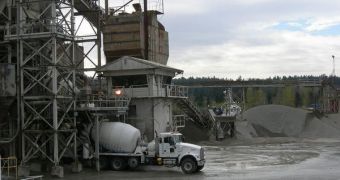Romans have been using forms of naturally occurring cement since before the year 0, in constructing aqueducts and other large infrastructures in their vast empire. The practice of using it has continued to this day, with most of the world's large buildings relying on it for their strength. As funny as it may sound, up until now, the molecular structure of this material has remained elusive to scientists trying to decode it. Now, experts at the Massachusetts Institute of Technology (MIT) have finally managed to crack the riddle, MIT News reports.
The industry around cement manufacturing is currently worth several billion dollars per year, and is present in most countries around the world. However, producing the material is a very dirty process, in that its carbon costs account for about five percent of the amount of carbon dioxide (CO2) emitted into the atmosphere each year. CO2 has been scientifically proven to be the main greenhouse gas driving global warming and climate change, in a large number of documented studies.
"Cement is so widely used as a building material that nobody is going to replace it anytime soon. But it has a carbon dioxide problem, so a basic understanding of this material could be very timely. We believe this work is a first step toward a consistent model of the molecular structure of cement hydrate, and we hope the scientific community will work with it," MIT Department of Nuclear Science and Engineering (NSE) Professor Sidney Yip says. The team of experts that decoded the molecular structure of cement hydrate went by the name "Liquid Stone."
"In every field there are breakthroughs that help the research frontier moving forward. One example is Watson and Crick's discovery of the basic structure of DNA. That structural model put biology on very sound footing," Yip adds. He is also the co-author of a new study presenting the team's finds, which is available in the week of September 7th's issue of the journal Proceedings of the National Academy of Sciences (PNAS). According to the paper, the finds that the experts made were a bit peculiar.
For a long time, scientists have assumed that cement has a clear, crystalline structure as a source of strength. They have believed the substance, also known as calcium-silica-hydrate, has an ordered geometry, consisting of layers of three-armed silica molecules (silica tetrahedra), interspersed with neat layers of calcium oxide. The investigation has revealed, however, that this is not the case. The cement hydrate rather has a mixed structure, resembling a crystalline one, but also an amorphous one, such as that that can be found in frozen liquids such as ice.
"We've known for several years that, at the nanoscale, cement hydrates pack together tightly like oranges in a grocer's pyramid. Now, we've finally been able to look inside the orange to find its fundamental signature. I call it the DNA of concrete. Whereas water weakens a material like tobermorite or jennite, it strengthens the cement hydrate," the Macomber Professor in the MIT Department of Civil and Environmental Engineering (CEE), Franz-Josef Ulm, also a co-author, adds.
"The 'disorder' or complexity of its chemistry creates a [heterogeneous], robust structure. Now that we have a validated molecular model, we can manipulate the chemical structure to design concrete for strength and environmental qualities, such as the ability to withstand higher pressure or temperature," he concludes.

 14 DAY TRIAL //
14 DAY TRIAL //